Neurofibra myelinata
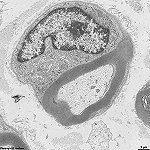
|
Markreiche Nervenfaser (Axon oder
Dendrit), die von mehreren Wicklungen der Zellmembran
von Scheidenzellen umwickelt ist. Im periphären Nervensystem handelt
es sich dabei um die Schwann'schen Zellen,
im zentralen Nervensystem um Oligodendrogliazellen.
Die isolierende Schicht wird als Myelinscheide bezeichnet. Sie und beschleunigt
die Reitzweiterleitung, die dann saltatorisch genannt wird, da die Impulse
nur an den Lücken zwischen benachbarten Scheidenzellen auftreten,
die Ranvier'sche Schnürringe genannt werden.
--> Informationen und Abbildungen zu Nerven,
Nervenendigungen,
Nervenfasern |
Myelinated nerve processes (axon
or dendrite) which is enshaded by multiple layers of the cell
membrane of a surrounding glial cell which is a Schwann cell in the
peripherical nervous system or an oligodendrocyte in the central
nervous system. The layers of isolating material are called myelin
sheath. It increases the speed of the impulse conduction that is termed
saltatory since potentials are only present at the gaps between two neighbouring
glial cells. These gaps are called nodes of Ranvier.
--> images and information about nerves,
nerve
terminals, nerve fibres |
Neurofibra nonmyelinata
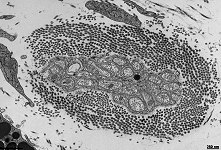
|
Marklose Nervenfaser; Nervenfaser, die nicht von einer Myelinscheide
umgeben ist. Die Nervenzellfortsätze (Axone oder Dendriten) sind entweder
ganz eingebettet in die Schwannsche Scheidenzelle
oder zum Teil frei wodurch sie an diesen Stellen Reize aufnehmen (Dendritische
Fortsätze) oder selbst Neurotransmittervesikel freisetzen können
(Axone).
--> Informationen und Abbildungen zu Nerven,
Nervenendigungen,
Nervenfasern |
Non-myelinated nerve cell processes, which are not enshaded
by a myelin sheath. These processes (axons or dendrites) are either fully
envaginated into the Schwann cell or partly
free. In the latter case they can either receive stimuli (dendritic processes)
or release neurotransmitters (axons).
--> images and information about nerves,
nerve
terminals, nerve fibres |
Neurofilamentum
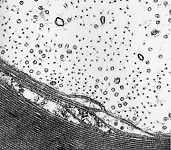
|
Neurofilament; Intermediärfilament
im Cytoplasma von Nervenzellen welches
sich in das Axon oder in Dendriten fortsetzt. |
Neurofilament; intermediate
filament in the cytoplasm of a
nerve cell body. It usually extends into the axon
or dendrites of the cell. |
Neuron
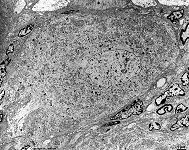
|
Nervenzelle; Zelle des Nervengewebes. Nervenzellen sind die einzige
Zellart, welche der Reizbildung und -weiterleitung dienen. Ihr Zellkörper
(Perikaryon oder Soma) besitzt stets nur einen Zellkern (Nucleus)
mit einem oder mehreren deutlich erkennbaren Kernkörperchen (Nucleolen)
und neben den üblichen Zellorganellen die nur in Neuronen auftretenden
Nissl-Schollen
(= basophiles Ergastoplasma, bestehend aus RER
und Polyribosomen). Nervenzellen weisen
unterschiedlich viele und verschieden lange Fortsätze auf. Ein Fortsatz
(unipolare Neuronen), zwei Fortsätze (bipolare) bis
mehrere Fortsätze (multipolare Neuronen) aufweist. Bei den
Fortsätzen unterscheidet man zwischen den Dendriten und dem Axon
(= Neurit). Die ein bis vielen Dendriten von Neuronen dienen der
Reizaufnahme, denn hier enden viele hundert bis tausende von Synapsen anderer
Nervenzellen. Jede Nervenzelle bildet nur ein Axon aus, welches
am Axonhügel mit dem Soma verbunden ist. In diesem Bereich werden
aus den Summenaktionspotentialen des Somas Folgen elektrischer Impulse,
die Aktionspotentiale gebildet, welche über die bis über 1 Meter
langen Axone zu den synaptischen Endverdickungen (synaptische Endkolben)
geleitet werden. Hier wird durch die Reize die Leitfähigkeit der Zellmembran
für bestimmte Ionen verändert, unter denen dem Kalzium besondere
Bedeutung zukommt. Beim Einstrom von Kalziumionen kommt es zur Ausschüttung
(Exocytose) von Botenstoffen (Neurotransmitter)
enthaltenden Vesikeln an der Membran (chemische Synapse).
Die Reize werden von einem Neuron zum anderen, oder von einem Neuron auf
eine Zielzelle weitergeleitet.
--> Informationen und Abbildungen zu Nerven,
Nervenendigungen,
Nervenfasern |
Neuron; a nerve cell, the structural and functional unit of the nervous
system. A neuron consists a cell body (perikaryon) and only one nucleus
containing one or more clearly visible nucleoles.
Apart from the usual cell-organelles these cells show Nissl bodies, which
are only seen here. These Nissl bodies consist of basophilic ergastoplasm
fromed by polyribosomes
and RER associated to each other. Neurons
have different numbers of processes varying in length. There is always
only one process that conducts electric impulses from the perikaryon to
subsequent cells, the axon or neurite. The
number of further processes is variable. These processes conduct electrical
impulses to the cell body and are called dendrites. The impulses
are generated by influx of ions when receiving stimuli from hundrets or
thousands of synapses from other nerve cells connected to these afferent
cell processes, the dendrites. A unipolar neuron lacks dendrites
and recieves impulses directly on its perikaryon. Real unipolar neurons
are very rare. Neurons with 2 processes (1 axon 1 dendrite) are called
bipolar,
those with two or more dendrites mulipolar. Neurons serve for initiation
and conduction of impulses. They transmit impulses to other neurons or
cells by releasing neurotransmitters at their terminal swellings that form
synapses.
The release of neurotransmittes that is an exocytosis
of vesicles containing specific chemical substances is initiated by influx
of calcium ions. Alternatively a neuron may release neurohormones into
the bloodstream. Synapses are fromed between neighbouring neurons or on
other target cells.
--> images and information about nerves,
nerve
terminals, nerve fibres |
Neurotubulus
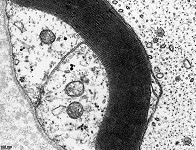
|
Neurotubulus; Mikrotubulus in den
Dendriten oder Axonen von Nervenzellen. Durchmesser
25 nm. |
Neurotubule; a microtubule in nerve
cells dendrites or axons 25 nm in diameter. |
Nexus (Macula communicans)
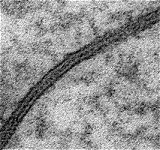 Abbildungen - images
Abbildungen - images |
Nexus = Gap-junction, hier bilden Membranproteine
durch den Interzellularraum hindurch tunnelförmige
Verbindungen, die als Konnexone bezeichnet werden, diese bestehen aus 6
Connexin 32 Untereinheiten in hexagonaler Anordnung. Nexus dienen der metabolischen
und ionalen Koppelung benachbarter Zellen, d.h. durch die Kanäle (Durchmesser
< 1,2 nm) können Wasser, Ionen und kleine Moleküle (< 1.500
Da), sowie cAMP von einer Zelle zur anderen übertreten. Die rundlichen
Zell-Zell Kontaktzonen haben einen Durchmesser von 0,1 – 1 µm, die
Zellmembranen sind hier ca. 2 – 4 nm voneinander entfernt. Die Bildung
erfolgt in wenigen Sekunden. Der Öffnungszustand der Poren wird durch
Ca++ und Mg++ beeinflußt.
--> weitere Informationen und Abbildungen |
Nexus = gap-junction, cell-cell contact zone 0,1 – 1 µm
in diameter with multiple communication channels. Here the cell
membranes have a distance of only 2 – 4 nm. The opening of the channels
is influenced by Ca++ und Mg++ concentrations and
have diameters < 1.2 nm. They allow small molecules (< 1,500 Da)
water and ions to pass. Connections are known as connexons, that consist
of 6 connexin 32 molecules in hexagonal order each. These integral membrane
proteins can form new gap junctions within seconds.
--> further information and images |
Nodus ranvieri
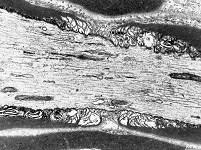
|
Ranvier'scher Schnürring; eine Lücke zwischen
zwei Schann'schen Zellen, die die Nervenfasern
umkleiden. Hier liegt der Nerv frei, so daß hier eine sehr schnelle
springende (saltatorische) Reizweiterleitung stattfinden kann.
--> Informationen und Abbildungen zu Nerven,
Nervenendigungen,
Nervenfasern |
Node of Ranvier; a space between two adjacent Schwann
cells along a nerve fiber; no myelin
sheath is present here. Thus the very fast saltatory conduction of impulses
takes place here.
--> images and information about nerves,
nerve
terminals, nerve fibres |
Nucleolus
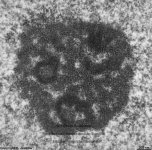
|
Kernkörperchen; kugelförmige Verdichtung im Zellkern
einer Zelle aus Ribosomenuntereinheiten, ribosomaler RNA und ribosomalen
Proteinen. Hier findet die Bildung von Ribosomen
statt. Eine Zelle kann mehrere Nucleoli haben.
--> weitere Informationen und Abbildungen |
Nucleolus; a spherical density in the nucleus
of a cell consisting of ribosomal subunits,
RNA and proteins. It is the site of synthesis of ribosomal RNA; a cell
may have more than one.
--> further information and images |
Nucleoplasma
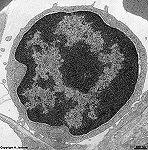
|
Kernplasma; das Protoplasma bzw. die Flüssigkeit des
Zellkerns.
--> weitere Informationen und Abbildungen |
Karyoplasm; the protoplasm (fluid) of the nucleus.
--> further information and images |
Nucleus
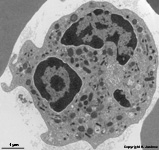
|
Zellkern; abgerenzter Bereich der Zelle, welcher die Erbinformationen
enthält.
--> weitere Informationen und Abbildungen |
Nucleus; the compartment of a cell that contains the genetic
information, which is responsible for the cell`s metabolism, growth, and
reproduction.
--> further information and images |
--> 












